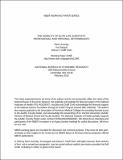The mobility of elite life scientists: Professional and personal determinants
Author(s)
Azoulay, Pierre; Ganguli, Ina; Graff Zivin, Joshua
DownloadSubmitted version (506.0Kb)
Terms of use
Metadata
Show full item recordAbstract
As scientists’ careers unfold, mobility can allow researchers to find environments where they are more productive and more effectively contribute to the generation of new knowledge. In this paper, we examine the determinants of mobility of elite academics within the life sciences, including individual productivity measures and for the first time, measures of the peer environment and family factors. Using a unique data set compiled from the career histories of 10,051 elite life scientists in the U.S., we paint a nuanced picture of mobility. Prolific scientists are more likely to move, but this impulse is constrained by recent NIH funding. The quality of peer environments both near and far is an additional factor that influences mobility decisions. We also identify a significant role for family structure. Scientists appear to be unwilling to move when their children are between the ages of 14–17, and this appears to be more pronounced for mothers than fathers. These results suggest that elite scientists find it costly to disrupt the social networks of their children during adolescence and take these costs into account when making career decisions.
Date issued
2017-04Department
Sloan School of ManagementJournal
Research Policy
Publisher
Elsevier BV
Citation
Azoulay, Pierre et al. "The mobility of elite life scientists: Professional and personal determinants." Research Policy 46, 3 (April 2017): 573-590 © 2017 Elsevier B.V.
Version: Original manuscript
ISSN
0048-7333